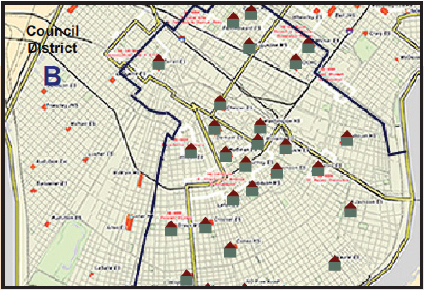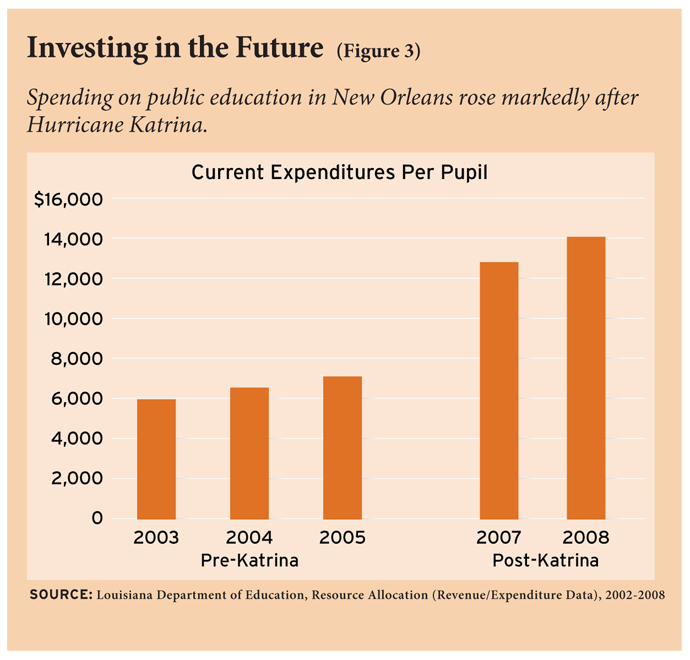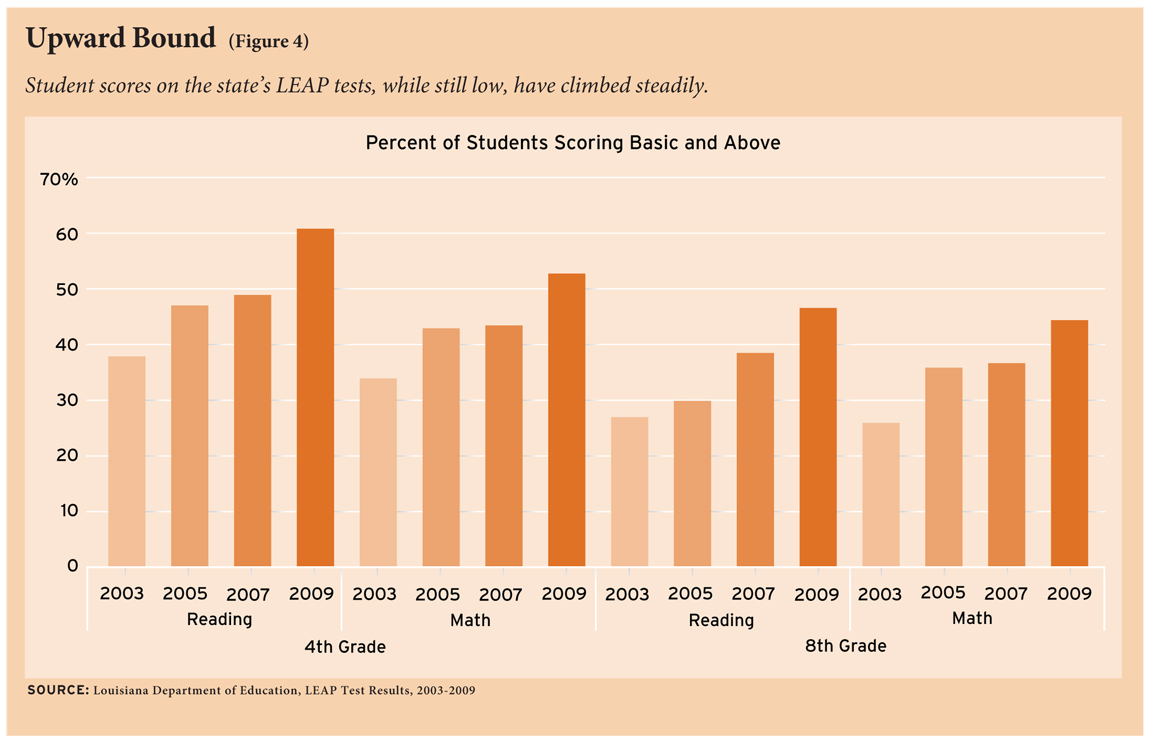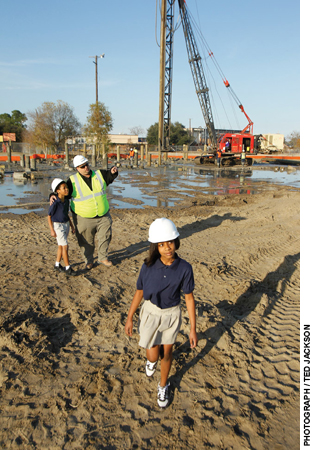 Five years after Hurricane Katrina, the New Orleans public schools bear little resemblance to the disintegrating system that was further undone by the catastrophic flood. Two-thirds of city schools in 2004 were rated “Academically Unacceptable” under Louisiana’s accountability standards; in 2010, about 4 in 10 rate that designation, and the percentage of students attending a low-performing school has fallen by half, from 67 percent to 34 percent. Most striking of all, nearly three-quarters of public school students attend charter schools, proportionally more than in any other U.S. city.
Five years after Hurricane Katrina, the New Orleans public schools bear little resemblance to the disintegrating system that was further undone by the catastrophic flood. Two-thirds of city schools in 2004 were rated “Academically Unacceptable” under Louisiana’s accountability standards; in 2010, about 4 in 10 rate that designation, and the percentage of students attending a low-performing school has fallen by half, from 67 percent to 34 percent. Most striking of all, nearly three-quarters of public school students attend charter schools, proportionally more than in any other U.S. city.
Just weeks after the storm, officials turned the city’s failing schools over to the state-run Recovery School District (RSD) and gave the RSD five years to turn them around. That deadline was reached last December, and a vote by the state school board has extended the RSD’s reform effort, albeit with modifications that promise greater autonomy to schools that meet performance targets and create a process for qualified operators to take over failing schools. The December vote was a victory for charter schools and the RSD, one that boldy advances a school reform model as innovative as it is controversial.
District in Recovery
For decades, the deterioration of the New Orleans public school system had been shocking and seemingly inexorable. Students graduating with honors were sometimes incapable of elementary mathematics and some were barely able to read. One high-school valedictorian failed the graduate exit exam and then failed it some more—five times all told—and this was the school’s top student. Deferred maintenance and contract fraud ensured that the system’s physical infrastructure was as degraded as its instructional capacity. The system was bankrupt and the payroll so padded with no-shows—some of them deceased—that the FBI had set up a satellite branch within the school board’s central office. The hurricane was the coup de grâce. Some 110 of 127 schoolhouses were completely destroyed.
But ruin so extreme bred opportunity.
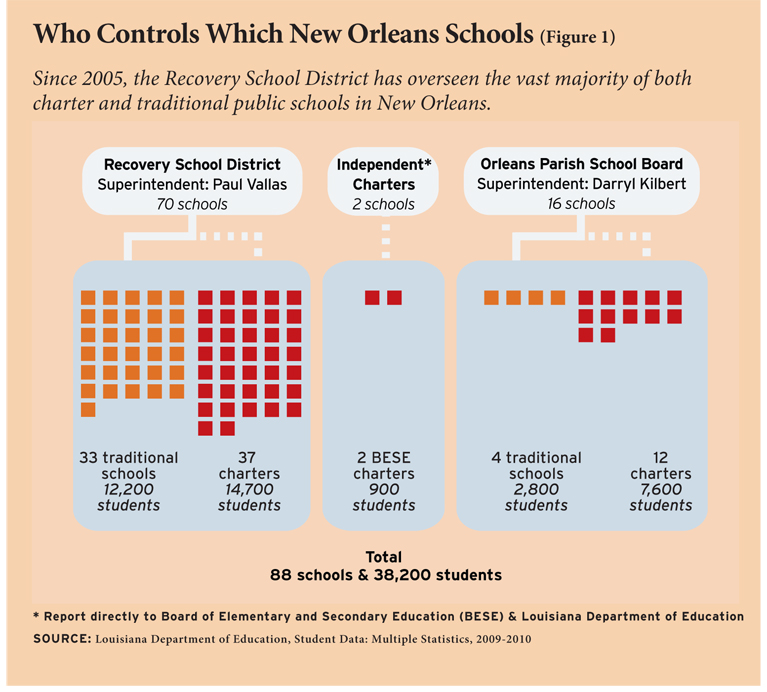 The RSD had been established in 2003 to manage “recovery” from academic failure, not from Hurricane Katrina, as the name is sometimes taken to imply, but had seized only five New Orleans schools before Katrina. After the storm, the RSD took control of an additional 63 deemed in need of radical intervention. The elected Orleans Parish School Board (OPSB) retained authority over the system’s 16 still-viable schools, an administrative domain that shrank further as several of the best schools fled central control for the greater autonomy that comes with charter status. Today, the majority of OPSB schools are charters (see Figure 1). Further erosion of the board’s legitimacy came with the jailing of its former president for bribery.
The RSD had been established in 2003 to manage “recovery” from academic failure, not from Hurricane Katrina, as the name is sometimes taken to imply, but had seized only five New Orleans schools before Katrina. After the storm, the RSD took control of an additional 63 deemed in need of radical intervention. The elected Orleans Parish School Board (OPSB) retained authority over the system’s 16 still-viable schools, an administrative domain that shrank further as several of the best schools fled central control for the greater autonomy that comes with charter status. Today, the majority of OPSB schools are charters (see Figure 1). Further erosion of the board’s legitimacy came with the jailing of its former president for bribery.
In a similarly pivotal blow to the old order, with teachers scattered to 50 states and schools shuttered for the 2005 fall term, the OPSB discharged the 7,000 employees who had answered to it prior to Katrina, effectively nullifying the system’s contract with United Teachers of New Orleans. When the collective bargaining agreement formally expired at the end of the 2005–06 school year, it was not renewed.
Freed from union rules and OPSB central-office control, the RSD was able to act on its conviction that improved performance lay in spinning off as many schools as possible and chartering them as independent institutions with open-enrollment admissions policies and citywide catchment areas. Critics on the left accused Louisiana of implementing a version of the “shock doctrine,” whereby disaster is exploited to rescind worker protections and other strands of the social safety net. Critics on the right lamented that the Bush administration and its allies within the parochial school establishment failed to go even further and make private school vouchers a bigger part of the new regime.
Five years later, the city’s bet on charter schools had begun to pay off. The average rate of improvement in the New Orleans public schools stood at three to four times the statewide rate, despite persistent poor performance by several schools. For a change, extraordinarily good things could be said about New Orleans’s traditionally atrocious public school system.Wake-up Call
Forced to compete for students and rank, the New Orleans schools were jolted from a decades-long coma. The awakening coincided with efforts in reform-minded cities like New York, Long Beach, California, and Washington, D.C. But what was distinctive about New Orleans was that the dynamic tension among schools was built into the system’s new polycentric administrative structure. The old apparatus of central control had not, as in other cities, merely been tweaked in the name of reform; it had been scrapped. Under the old order, the all-powerful school board and central office had seemed to view the district more as an adult jobs program and dispenser of patronage-based contracts than as a source of education for young people. Now, by design, no single apparatus of power—not OPSB, RSD, or the charter schools and charter management organizations that answered to them and to the Louisiana Board of Elementary and Secondary Education (BESE)—could assert hegemony and dominate the others.
That made New Orleans a test not just of cutting-edge instructional practices but of variant administrative models as well. The city became a laboratory for the reinvention of its school system and, as was attested to by the enthusiasm of major foundations and the Obama administration, a crucible for ideas that might well be replicable in other cities.
As reformers hoped, the opportunity attracted a raft of independent school service providers ranging from charter management organizations to firms that aligned curricula with state standards and then developed metrics for measuring individual student achievement on a monthly or even weekly basis. Teach For America and the New Teacher Project saw opportunity and beefed up their presence in New Orleans, as did a homegrown organization called Teach NOLA. The Louisiana Association of Public Charter Schools gained prominence as a deft legislative advocate for what was being called the New Orleans reform model. The largest of the independent reform groups, the nonprofit New Schools for New Orleans (NSNO), developed an array of services, subsidies, and other forms of support. To plug the human capital deficit in a city still depopulated by Katrina, NSNO began training prospective school leaders and directors as well as teachers. It also sponsored a small nonprofit to engage and inform parents about student choices in the new landscape. By 2010, NSNO had incubated 10 citywide, open-admission charter schools, the basic integer of local reform, and provided key personnel and services for dozens more.
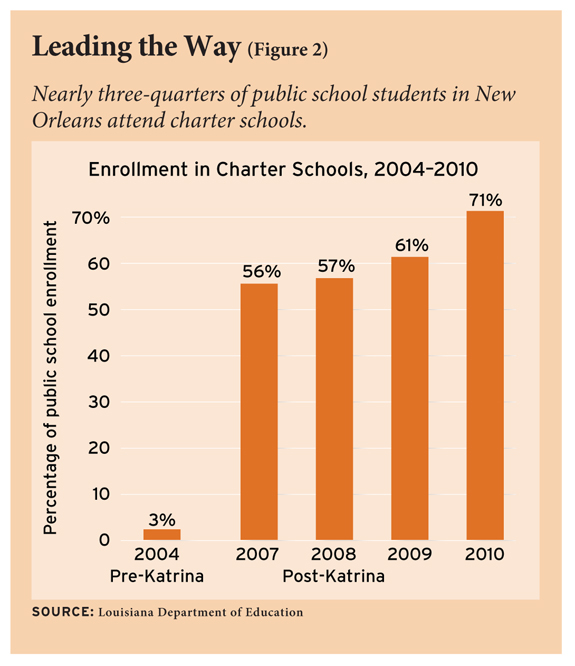 Katrina spawned a gamut of visionary ideas for the transformation of New Orleans. They ranged from land-use plans to flood protection to the development of neighborhood health-care clinics to economic development and governance proposals. Many died at inception, undone by the impulse to re-create the old order before attempting its improvement. School reform was the exception. A sense of moral obligation combined with hard work and sheer exasperation to make it the most far-reaching achievement of the post-Katrina era. The decent public education long denied New Orleans youth was framed as a civil right at least as fundamental as the access to jobs, public accommodations, and polling places that had been milestones in an earlier generation’s fight to overcome segregation. The numbers show that charter schools were the barricades from which a new struggle was being waged successfully (see Figure 2). Parents, initially skeptical about school reform efforts, or accustomed to thinking of them as concessions aimed largely at luring parochial and private school students back into a low-income, black-majority system, flocked to the new schools, even lining up in pre-dawn hours to assure a child’s admission. Alone among American cities, New Orleans was actually beginning to close the much-discussed “performance gap” among students of different racial, ethnic, and economic backgrounds. A poll in late autumn 2010 by Tulane University’s Cowen Institute for Public Education Initiatives found that 60 percent of New Orleans residents opposed returning the schools to OPSB. Small wonder then that many politicians had loosened their ties to teachers unions and school system contractors. Change was in the air and the implications were revolutionary.
Katrina spawned a gamut of visionary ideas for the transformation of New Orleans. They ranged from land-use plans to flood protection to the development of neighborhood health-care clinics to economic development and governance proposals. Many died at inception, undone by the impulse to re-create the old order before attempting its improvement. School reform was the exception. A sense of moral obligation combined with hard work and sheer exasperation to make it the most far-reaching achievement of the post-Katrina era. The decent public education long denied New Orleans youth was framed as a civil right at least as fundamental as the access to jobs, public accommodations, and polling places that had been milestones in an earlier generation’s fight to overcome segregation. The numbers show that charter schools were the barricades from which a new struggle was being waged successfully (see Figure 2). Parents, initially skeptical about school reform efforts, or accustomed to thinking of them as concessions aimed largely at luring parochial and private school students back into a low-income, black-majority system, flocked to the new schools, even lining up in pre-dawn hours to assure a child’s admission. Alone among American cities, New Orleans was actually beginning to close the much-discussed “performance gap” among students of different racial, ethnic, and economic backgrounds. A poll in late autumn 2010 by Tulane University’s Cowen Institute for Public Education Initiatives found that 60 percent of New Orleans residents opposed returning the schools to OPSB. Small wonder then that many politicians had loosened their ties to teachers unions and school system contractors. Change was in the air and the implications were revolutionary.
Sustaining Momentum
Now, the question, as keenly studied by chartering’s foes as by its friends, is this: Can the early success be sustained? The challenges remain numerous and daunting. There is concern that school reform’s bountiful harvest in the half decade since Katrina has been low-hanging fruit and that further gains—even with sharp improvement, the system remains subpar—will be much more difficult. Looking ahead, Neerav Kingsland, a Yale Law graduate and strategist for NSNO, talks about “Charter Issues 2.0,” the problems that arise on the way from being 10 percent of the system to being 80 percent of the system, the next and far more demanding phase of work.
For the nation’s foremost experiment in charter schools to rest even briefly on its laurels would be to risk setbacks, Kingsland and like-minded reformers contend. Loss of momentum would be pounced on by now-disenfranchised partisans of the old regime eager to buttress their claim that the rising test scores are somehow bogus or, in any event, temporary, merely a blip. That argument has been made by Larry Carter, president of the United Teachers of New Orleans. Like other skeptics, Carter seized on a 2010 report from Stanford University’s Center for Research on Education Outcomes that portrayed many charter schools as doing no better, and indeed sometimes worse, than traditional schools nationwide. Carter rushed into print in New Orleans’s daily newspaper, The Times-Picayune, with an editorial saluting the Stanford study as proof of failure, but without mentioning the parts of the report that identified charters in New Orleans as a sharp exception to the national numbers and particularly successful with low-income students. In light of rearguard attacks of this sort, the only way to ensure that the system remains performance-driven, many of reform’s proponents believe, is to push the New Orleans model—predicated on open-admission, citywide charter schools—all the way to scale. That means encouraging the RSD to complete the chartering of its entire portfolio of schools; it also means resisting return of a still-shaky school system to OPSB, with or without a collective bargaining agreement. Above all, sustaining charter-based school reform means taking very seriously the criticisms that have been lodged against it.
The Search for a Governance Model
The 2005 legislation that designated New Orleans a district in crisis and placed more of its failing schools under state control gave the RSD five years to achieve recovery. The timetable guaranteed that school governance would emerge as a focus of debate on Katrina’s fifth anniversary. Eli Broad, whose foundation has committed millions to the reform effort, put the governance question at the top of the agenda as schools reopened for the 2010–11 school year:
The most important areas in which we think the city should focus going forward are putting in place a sustainable governance structure, continuing to develop and support teachers and leaders to become long-term, high-performing employees and continuing to improve the lowest-performing schools.
Last December BESE decided to extend the RSD’s shelf life rather than return the schools to OPSB control. In the run-up to the December decision, public interest swelled and rhetoric heated up. Opponents of the state’s post-Katrina intervention rallied to the cry of “local control,” which usually meant restoring power to the school board or something like it. The argument carried a racial subtext, sometimes explicit, more often coded. The bureaucrats in a white-majority state were cast as having usurped administrative power over a district in which 9 out of 10 students were African American, as were many teachers, politicians, and contractors.
Another theme popular among advocates of local control was the contention that RSD’s school performance gains were somehow illusory or rigged: students with special needs were being turned away from schools and those with disciplinary problems were being expelled to keep performance scores high, critics insinuated. The argument lost some of its political punch when 2009–10 enrollment figures revealed that the schools overseen by the OPSB, not the RSD, have the lowest proportion of special needs and behaviorally challenged students.
State Superintendent of Education Paul Pastorek, shortly after Labor Day, pointed the way for BESE’s December decision. The gist of his recommendation was that RSD would retain control of its current portfolio of schools for at least another two school years. At that point, schools that had met or surpassed minimum standards could return to local governance, if—the big if—they chose to do so. Pastorek’s further proviso was that local capacity to administer the schools would be reviewed before such transfers were approved. Many, if not most, eligible schools are expected to resist a return to OPSB control. In a late amendment to his plan calculated to impose greater accountability on the RSD, Pastorek advocated giving OPSB and others a crack at taking over not just successful schools, but also those that are still failing after five years in the RSD portfolio.
The December vote was not a foregone conclusion. Some board members were inclined to override Pastorek’s recommendation and restore the entire city system to OPSB control. But former OPSB and BESE board member Leslie Jacobs, widely regarded as the founder of Louisiana’s school reform movement, correctly predicted that BESE did not have the votes to oppose Pastorek.
Darryl Kilbert, the superintendent hired by OPSB to manage its small portfolio of schools, portrays the current transitional arrangement as an erosion of democracy itself and espouses restoration of “community control.” He tactfully makes clear that community control need not necessarily mean OPSB control, but clearly assumes that it will.
The countervailing observation is that the locus of democratic control has merely shifted, from an elected school board to an elected governor and a partly elected, partly appointed BESE. The mantralike criticism that a diminished OPSB means control is less “local” ignores the fact that the once all-powerful seven-member school board has been augmented by a growing cohort of charter school board members numbering in the hundreds. (The Left counters by deploring the charter schools as “privatized,” notwithstanding that most of them observe an open-enrollment admissions policy and that they, like all public schools in Louisiana, are publicly authorized, funded, and evaluated. By statute, their meetings must also be open to the public, though critics say access is sometimes grudging.)
While its argument for regaining control of the schools rested on the principle of local control, a chastened OPSB also pointed out that it had instituted financial reforms since the system’s bankruptcy prior to Katrina.
But the broader political context was aligned in ways that favored continuing the reform effort, at least for now. Under the New Orleans city charter, the school system is a separate entity that does not answer to the mayor, but the incumbent administration, like the state education bureaucracy in Baton Rouge, was and remains vehemently opposed to cutting it short.
“There will be no turning back,” New Orleans mayor Mitch Landrieu said to cheers in his inaugural address in May 2010. He was reiterating a slogan that had been embedded in his campaign platform. If reform were to fail, he asserted in a network TV appearance in late September, it would be precisely because politics, perhaps especially racial politics, had eclipsed the commitment to improve the education of children. Landrieu is white and a Democrat, the first white mayor of New Orleans since his father served in that capacity in the 1970s, but he was elected with overwhelming black support. Governor Bobby Jindal, a conservative Republican and a devout Catholic, is even less disposed to resurrect the old regime. Indeed, he is a proponent not only of charter autonomy but of vouchers, which though ardently desired by the parochial system, are so far only a token presence in the New Orleans schools landscape (see “In the Wake of the Storm,” features, Spring 2010).Paul Vallas, who as superintendent of the RSD since 2007 has lengthened both the school day and the school year, sees technical as well as political reasons why charters are here to stay. “You can’t turn back. Charters are authorized by the state,” Vallas told PBS Newshour during a July 2010 appearance. “The state would have to not renew them. The great thing about this system is, it’s really going to be hard to dismantle what’s been created.”
The influential Jacobs agrees. OPSB couldn’t roll back the clock even if it wanted to, Jacobs contends; the charter school constituencies—the families who use them—won’t let it happen.
And yet Jacobs, like many others, including Eli Broad, sees eventual return to an upgraded form of local control as both inevitable and wise. In the interim, every governmental entity with a management role in local schools, and that would include BESE, must maintain a local presence to facilitate citizen access, she told an independent citizens forum on school governance that met throughout the summer. Longer term, she believes any resolution of the governance question must observe two categorical imperatives: One is that any and all decisions must be based on whether they measurably improve the quality of the education being provided to children. The other is that the management of schools must be cleanly separated from the business of authorizing and evaluating them.
Extrapolating from these core values, Jacobs envisions a school board–like body, perhaps the OPSB itself, eventually recovering the power to authorize charters, reorganize failing schools, set policy consistent with state mandates, and provide systemwide services. Actual management of schools would be left to autonomous charter boards, each of which comprises a school “district” under the current arrangement.
Building Anew
As the December vote was approaching, Jacobs was also grappling with the question of whether central administrative functions should include facilities management, or whether that responsibility should lie with the schools that occupy assigned campuses. The real estate is owned by OPSB and is subject to reconstruction or replacement now that the city has finally settled with the Federal Emergency Management Agency (FEMA) for a post-Katrina allocation of construction funds totaling $1.8 billion—big, big money in a relatively small city like New Orleans (see sidebar).
NO’s Master Plan Under Way
It’s the biggest school construction project in Louisiana since the Civil War and one of the largest in the nation’s history: 85 campuses, some overhauled, most being built from the ground up, at a total cost of about $2 billion. Another 89 buildings on 38 campuses are being demolished. By 2016, New Orleans anticipates a student population of about 45,000, compared to about 65,000 before Katrina.
With the system in the throes of convulsive reform, the buildings are master-planned for flexibility. Not only is the population in flux, so are school management styles at a time of increased autonomy and experimentation. A charter school operator may be around for three to five years, but these are buildings that must last for a century, notes Ramsey Green, who, as the Recovery School District’s chief operating officer, is in charge of creating campuses for both RSD and OPSB schools, charters and direct-run alike. (For project news, interactive map, and photographs, visit www.rebuildingnolaschools.com.)
As the work kicked in, Louisiana got its first public building that meets the LEED “silver” standard for “greenness”—as will all 85 schools. The buildings also reflect the city’s vulnerability to storms and flooding: Many are elevated above flood levels. Ground floors are terrazzo so they can be easily scrubbed down and bleached if flooding occurs. The electrical systems originate on the roof and flow down through the buildings so that only the lower extremities need to be replaced in the event of catastrophic flooding.
Of particular interest to progressives in the urban planning world, the buildings embody the potential for multiple uses by the surrounding community. Libraries and gyms and health clinics have separate entrances, allowing community groups to gain access for appointments, meetings, or after-hours exercise without having to traipse through the school itself. Air-conditioning and heating systems are zoned to contain costs when a building is only partially in use.
In a city famous for corruption, procurement and payment are audited exhaustively at several levels within the RSD and at the state and federal level before checks are actually cut by FEMA. Early bids have been running nicely below estimates, thanks to the national recession, Green says.
Momentum has been building rapidly since early 2010, when the city and FEMA ended five years of squabbling and came to terms on the federal commitment. Autumn saw eight groundbreakings, one a week. The excitement is palpable. So is the urgency of the work. Says Green, “We’ve still got 6,000 kids in modular campuses.”
Where those schools should be placed and what they should look like has long stirred debate. Some factions have clamored for a return to “neighborhood schools.” To some, this is code for an antireform agenda, given that citywide open access is one of the hallmarks of the new generation of charter schools since Katrina. That open access is a deliberate and effective assault on racial inequity associated with the segregation era is an irony not lost on reform advocates. In debating the issue, they point out that charters with open-access admission policies are an option already available to neighborhood residents; for admission to most they need only show up on time and enroll. Moreover, reform advocates note, basing admissions on geographical boundaries is an exclusionary practice, all too redolent of the days when low-income students of minority background desperately sought to escape from “slum” or “ghetto” schools and gain access to the generally superior schools in “good” neighborhoods from which they had been barred.
The neighborhood schools movement has found friends among some of the city’s more progressive urban planners. The master plan for reconstruction of the school system after Katrina envisions schools as centers of the adjacent community. At a time when budgets are tight, obesity epidemic, and fuel costs likely to rise, schools at the center of walkable communities are seen as both healthful and thrifty. School-centered communities also further neighborhood cohesiveness, the argument goes. To that end, the Orleans schools master plan calls for bundling several community services within or adjacent to new and reconstructed schools—a library branch, a wellness clinic, a community garden, and a senior center, for example.
No discussion of school reform in New Orleans is complete without acknowledging that notable gains have occurred at a time of unusually high levels of government financial support, chiefly drawn from special funds set up in the aftermath of the Katrina disaster. Those dollars nearly doubled per-student allocations in New Orleans, lifting the figure above $12,000, even without factoring in support from foundations and individual donors (see Figure 3). That tide of money has now begun to ebb. It was hoped that reversion to more normal funding levels would be mitigated by federal Race to the Top (RttT) money, but Louisiana was not selected in the program’s first two rounds, in part, it was assumed, because upstate districts and teachers unions were not wholehearted in their support for RttT goals.
New Orleans has, however, secured $28.5 million in federal “i3” funds for educational innovation. The award, announced over the summer of 2010, will go to the RSD and to NSNO primarily to lubricate reorganization of failing schools. To test the replicability of the New Orleans model, some of the money will be used to help launch charter schools in Memphis. On the home front, NSNO is committed to implementing i3’s goal of reorganizing the lowest-performing 5 percent of failing schools. The intended uses of the i3 money align with an evolving vision of philanthropy’s role. As Broad put it,
Foundations can continue to play an important role in enabling school districts and states around the country to understand how and why New Orleans has made better relative academic gains in such a short period of time, and to encourage them to adopt similar approaches. We’ve only begun to unlock the lessons this city holds for education reform nationwide.
In early December 2010, notwithstanding a lawsuit threatened by OPSB, BESE accepted Pastorek’s recommendation to extend the current reform paradigm. The vote was preceded by histrionics at times reminiscent of pre-Katrina meetings of the Orleans school board at its most chaotic and dysfunctional. From the speaker’s rostrum, one OPSB member warned that a vote for Pastorek’s plan would be an act of criminal malfeasance that would trigger “civil war,” an indication that regardless of the board’s decision, the political battle was far from over.
Where to Go from Here
Amid changes as exciting as they are fragile, this much seems clear to the reform community: Even briefly settling for today’s improved performance levels is to avail critics of the opportunity to say that school reform has stalled after early gains that were easy and perhaps unsustainable (see Figure 4). It would be to settle for schools that are, not excellent, but merely “good enough.”
Efforts by the old order to claw back power are portrayed as only the most obvious threat to the gains achieved in New Orleans. The more insidious threat, reformers contend, is for schools and the communities of students and parents they serve to get comfortable with a still-inadequate status quo. A stubborn loyalty to the school they know, and indeed may have helped build, can abort the wrenching changes that may be required for a school to become truly excellent.
Reform advocates call it “churn,” the business of aggressively and systematically zeroing in on the least successful schools, ousting failed managers, and reorganizing the schools as open-enrollment, citywide charter schools. Churn is “disruptive,” a term of approbation in the school reform lexicon. But disruption breeds resistance. Even badly failing school administrations sometimes secure the affection of parents and students uncertain that striving for a truly excellent school will necessarily lead to improvement of the mediocre institution with which they have grown comfortable. That psychology is what for a time bedeviled the process of replacing a popular principal at the International High School of New Orleans, a BESE charter, with a controversial but dynamic former superintendent of the New Orleans system. In other school settings the resistance is communitarian or racial. The delicate and sometimes unpleasant politics of churn are the reason many reformers question whether an elected body, such as a traditional school board, has the gumption to handle tasks as potentially unpopular as declaring schools to be failures and handing them over to more capable managers, or shuttering them altogether.
Resolving the issue of governance will be the biggest test ahead for cities engaged in Charter Issues 2.0. At stake is not just the credibility of the reform movement but the prospect, at last, of convincing America that an excellent education is a civil right worth the kind of struggle that so far is exhilarating New Orleans with the possibility of transformational change.
Jed Horne educated two sons in Orleans Parish public schools. He is the author of Breach of Faith: Hurricane Katrina and the Near Death of a Great American City.


